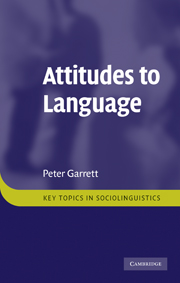Book contents
- Frontmatter
- Contents
- List of figures
- List of tables
- Acknowledgements
- 1 Introduction
- 2 Fundamentals of language attitudes
- 3 Main approaches to the study of language attitudes
- 4 Matched and verbal guise studies: focus on English
- 5 Matched and verbal guise research in more contexts
- 6 Attitudes to speech styles and other variables: communication features, speakers, hearers and contexts
- 7 Communication accommodation theory
- 8 Language attitudes in professional contexts
- 9 Societal treatment studies
- 10 Direct approach
- 11 Folklinguistics
- 12 An integrated programme of language attitudes research
- 13 Conclusion
- Glossary
- References
- Index
- References
9 - Societal treatment studies
Published online by Cambridge University Press: 05 June 2012
- Frontmatter
- Contents
- List of figures
- List of tables
- Acknowledgements
- 1 Introduction
- 2 Fundamentals of language attitudes
- 3 Main approaches to the study of language attitudes
- 4 Matched and verbal guise studies: focus on English
- 5 Matched and verbal guise research in more contexts
- 6 Attitudes to speech styles and other variables: communication features, speakers, hearers and contexts
- 7 Communication accommodation theory
- 8 Language attitudes in professional contexts
- 9 Societal treatment studies
- 10 Direct approach
- 11 Folklinguistics
- 12 An integrated programme of language attitudes research
- 13 Conclusion
- Glossary
- References
- Index
- References
Summary
Societal treatment studies tend to receive less attention in contemporary discussions of language attitudes research. Nevertheless, it is certainly a significant approach for gaining insights into the relative values and stereotypical associations of language varieties. Broadly speaking, the approach is seen in terms of the ‘treatment’ afforded languages and language varieties within society, and to their users. Studies that are gathered together under this heading include observational, participant observation and ethnographic studies, and studies of many sources in the public domain. Chapter 3 included reference to one or two societal treatment studies examining letters to editors, etiquette books and language use in cartoons, for example. Other published studies have looked at government and educational policy documents and their view of languages in school systems (e.g. Mitchell 1991; Cots and Nussbaum 1999), the use of dialect in novels (Rickford and Traugott 1985) and differences in English usage in newspaper style books (Metcalf 1985). There is indeed much diversity amongst the studies placed in the societal treatment category. In this chapter we pick out two themes where there has been sufficient focus of attention to create a body of work, albeit still a small one. One topic is the use of languages in consumer advertisements, and the other concerns recent work on linguistic landscapes.
LANGUAGE USE IN CONSUMER ADVERTISEMENTS
Consumer advertising has provided an informative source of societal treatment material. Studies of bilingual or multilingual advertisements can highlight how different languages convey cultural resonances in a particular culture.
- Type
- Chapter
- Information
- Attitudes to Language , pp. 142 - 158Publisher: Cambridge University PressPrint publication year: 2010

